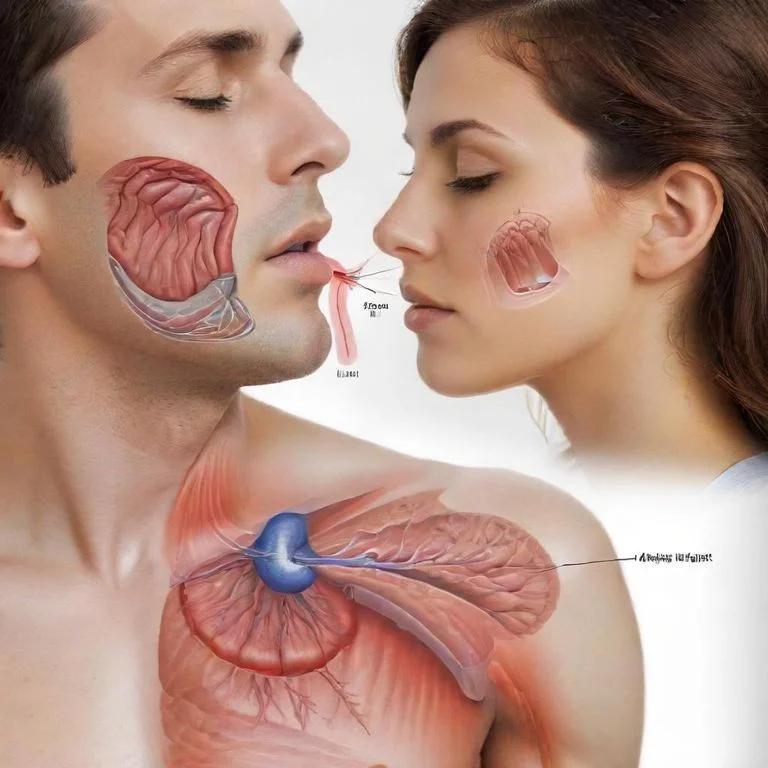
Why Wheezing When Lying Down Happens and How to Manage It
What Happens During Wheezing When Lying Down
Wheezing refers to a distinctive whistling or musical sound that occurs when air moves through narrowed breathing passages in the lungs. It can happen at any time, but some people notice it more clearly when lying down. This change in position can subtly alter how air flows through the chest and airways, making any underlying narrowing more noticeable. While it may feel alarming, wheezing when lying down is often related to treatable conditions such as temporary airway irritation, mild congestion, or chronic respiratory issues like asthma.
When a person reclines, gravity and the weight of the chest wall can slightly compress the airways. This supine posture also influences how mucus and air move through the lungs, increasing the tendency for a high-pitched sound during breathing. Understanding this connection between body position and breathing helps patients recognize patterns and discuss them more clearly with their healthcare provider.
How Wheezing Sounds and Feels
Wheezing is typically described as a soft to sharp whistling sound that occurs when breathing out, though it can occasionally be heard during inhalation. Some describe it as a faint squeak or a gentle musical note that repeats with each breath. It differs from snoring, which arises in the upper throat, and from crackling sounds associated with fluid in the lungs. Patients may first notice wheezing in quiet settings or at night, especially when lying still or trying to fall asleep.
- Wheezing: A whistling or musical noise from narrowed airways.
- Snoring: A low, vibrating sound from the throat during sleep.
- Crackles: Popping sounds often linked to fluid in the lungs.
The sensation accompanying wheezing can vary-some feel chest tightness or mild difficulty taking a deep breath. These feelings usually improve when sitting upright, showing that posture plays an important role in how freely air can move through the lungs.
Why Position Matters
When lying flat, gravity shifts the position of the diaphragm and lungs, reducing the available space for air exchange. This can narrow smaller air passages, particularly in individuals with sensitive or inflamed airways. The mechanics of breathing change as the chest wall and abdominal contents exert pressure on the lungs, which can worsen airflow resistance and make wheezing more noticeable.

For some, this wheeze may come and go depending on posture, congestion, or breathing effort. In others, it may point to an underlying lung or airway condition that becomes more evident at rest. Recognizing these patterns early allows for timely discussion with a healthcare provider, who can determine whether the cause is temporary irritation or a sign of a chronic respiratory problem.
Common Causes of Wheezing When Lying Down
Wheezing that becomes noticeable or worsens when lying flat can arise from several medical conditions. These include lung diseases, airway irritation, or even heart-related causes that affect airflow. While the sound may seem similar across causes, the underlying mechanisms can differ greatly. Understanding these distinctions helps patients and clinicians identify patterns and guide effective treatment. In many cases, more than one condition may contribute to the symptom.
Asthma and Chronic Lung Conditions
- Asthma: The airways become inflamed and overly sensitive, leading to muscle tightening and partial obstruction of airflow, producing a whistling sound.
- Chronic Obstructive Pulmonary Disease (COPD): The airways remain persistently narrowed due to long-term inflammation, causing constant or episodic wheezing, often worse at night.
- Respiratory Infections: Viral or bacterial bronchitis can irritate the airway lining, leading to temporary wheezing that may worsen when reclining if mucus shifts within the lungs.
Lying down can make these conditions more noticeable as chest pressure increases and lung expansion decreases, emphasizing how posture affects breathing.
Reflux and Sinus-Related Triggers
Acid reflux, or gastroesophageal reflux disease (GERD), can play a hidden role in wheezing when lying down. Stomach acid that moves upward into the esophagus may irritate the throat or airways, leading to coughing or a wheeze-like sound. This irritation is more likely when the body is horizontal, as gravity no longer helps keep stomach contents in place.
Similarly, postnasal drip from sinus congestion can cause mucus to flow into the lower throat during rest, leading to airway narrowing and mild wheezing sensations. These reflux- or sinus-related triggers may not involve the lungs directly but can still inflame the upper airways, increasing resistance to airflow and producing a sound that mimics lung-based wheeze.
| Trigger | Main Effect | When It Worsens |
|---|---|---|
| GERD | Acid irritates throat and airways | When lying flat after meals |
| Postnasal Drip | Mucus drains into lower throat | During sleep or reclined rest |
Cardiac and Structural Causes
Not all wheezing originates from lung disease. In some individuals, heart conditions such as heart failure can lead to fluid buildup in the lungs, producing a sound similar to wheezing. This symptom, called orthopnea, tends to occur when lying flat and improves when sitting upright. The underlying issue involves pressure changes in the chest that affect both the heart and airways, leading to airflow limitation.
Less commonly, structural changes in the airways can also cause wheezing that varies with position. In dynamic airway collapse, the airway walls become overly flexible and may partially close when a person lies down or exhales forcefully. This posture-dependent narrowing increases resistance to airflow, creating a temporary whistle-like sound.

Myths vs Facts
- Myth: Wheezing when lying down always means asthma.
- Fact: Wheezing can also result from heart conditions, airway collapse, infections, or reflux-related irritation.
- Fact: Multiple causes may overlap, so professional evaluation is essential for accurate diagnosis.
When Wheezing Becomes a Serious Problem
Wheezing can range from a mild, short-lived episode to a sign of a more serious underlying condition. While occasional wheezing may not always be urgent, certain warning signs indicate the need for prompt medical attention. Recognizing these red flags early can prevent complications and ensure that any underlying health issue is treated appropriately.
Recognizing Red Flags
Some symptoms should never be ignored. If wheezing is accompanied by severe shortness of breath, chest tightness, or a feeling of not getting enough air, immediate medical evaluation is essential. Difficulty speaking in full sentences, blue or gray discoloration around the lips or fingertips, and confusion or fatigue can signal low oxygen levels in the blood. These may reflect hypoxia or worsening airway obstruction, both requiring urgent treatment.
- Severe shortness of breath or chest tightness
- Inability to speak in full sentences
- Bluish lips, fingertips, or skin
- Sudden worsening of wheezing or rapid onset of symptoms
- Confusion, fatigue, or faintness during an episode
Another red flag is wheezing that develops suddenly and worsens rapidly. This pattern may indicate a severe asthma flare, an allergic reaction, or another acute issue narrowing the airways. When symptoms progress within minutes to hours, emergency care should be sought without delay.
When to Call a Doctor
Even if symptoms are not severe, persistent or recurrent wheezing should not be ignored. When wheezing interferes with sleep, daily activity, or occurs mainly when lying down, it may suggest an underlying condition such as asthma, reflux, or heart-related problems that need medical evaluation. Contact a healthcare provider if wheezing lasts for several days, recurs frequently, or is associated with breathlessness on exertion.
Monitoring how symptoms change-such as becoming more frequent or lasting longer-can help doctors identify patterns and provide early intervention. Seeking care before symptoms worsen is the safest way to maintain healthy breathing and prevent emergencies.

When to See a Doctor
- Seek emergency help if wheezing comes with severe breathlessness, chest pain, or bluish lips or skin.
- Call your doctor if wheezing is recurrent, interferes with sleep, or worsens over time.
- Keep track of when wheezing occurs-especially if it happens mainly when lying down-to help your clinician determine the cause.
How Doctors Diagnose Wheezing When Lying Down
Diagnosing wheezing when lying down involves a careful, step-by-step evaluation. Doctors focus on identifying triggers and signs that reveal whether the lungs, heart, or upper airways are involved. The process usually begins with a discussion about symptoms, followed by a physical examination and specific diagnostic tests tailored to the individual.
Clinical Evaluation
The first step is a thorough medical history. Clinicians ask when wheezing occurs-whether mainly at night, after lying flat, or during certain activities. They also inquire about symptoms like shortness of breath, cough, or chest discomfort, and whether these improve when sitting upright. Understanding positional and nocturnal patterns helps narrow down causes such as asthma, reflux, or heart-related conditions.
- Timing of symptoms (nighttime, after lying down, or exertion)
- Associated symptoms such as shortness of breath, chest tightness, or cough
- Changes in symptoms when sitting upright versus lying flat
- History of asthma, reflux, heart disease, or allergies
During the examination, doctors listen to the lungs for the timing and location of wheezes and look for signs like swelling or bluish skin that suggest reduced oxygen levels or airway obstruction. This combination of history and examination provides essential clues before testing.
Tests and Investigations
Objective testing confirms the diagnosis. Spirometry measures how much air a person can exhale and how quickly it leaves the lungs. This may include a bronchodilator trial to check for improvement-an indicator of asthma. If symptoms persist, further tests may follow.
| Test | Purpose | What It Detects |
|---|---|---|
| Spirometry | Measures airflow and lung function | Asthma, COPD, or airflow obstruction |
| Chest X-ray or CT scan | Visualizes lung and airway structures | Structural abnormalities or infection |
| Bronchoscopy | Uses a camera to view airways directly | Airway collapse or obstruction |
| Reflux or sleep study | Evaluates non-lung causes of symptoms | GERD or sleep-related airway issues |
Imaging studies such as X-rays or CT scans can reveal structural problems or infections. When airway collapse is suspected, bronchoscopy allows doctors to directly visualize the airways. Additional tests-like reflux studies or sleep evaluations-help identify non-pulmonary contributors to wheezing while lying down. These findings together support an accurate diagnosis and personalized treatment plan.

How to Prepare for Your Appointment
- Keep a symptom diary noting when wheezing occurs and what positions trigger it.
- Record how long each episode lasts and any changes in intensity.
- Bring a list of current medications and any recent health changes to review with your doctor.
Managing and Preventing Wheezing When Lying Down
Reducing or preventing wheezing when lying down begins with identifying its root cause. Treatment plans may combine medications, lifestyle adjustments, and positional strategies that help keep the airways open and minimize irritation. Because wheezing can stem from different conditions-from asthma and reflux to sleep apnea or heart-related issues-addressing the specific cause is key to long-term relief and better breathing comfort.
Medical and Lifestyle Treatments
Doctors tailor treatment based on the underlying diagnosis. For asthma, inhaled medications reduce inflammation and relax the airway muscles, while infections may require antibiotics or other short-term therapies. If gastroesophageal reflux disease (GERD) is contributing to symptoms, acid-suppressing medications and dietary modifications can reduce airway irritation. People with sleep apnea may benefit from positive airway pressure therapy or devices that maintain open airflow during sleep.
- Asthma: Inhaled medicines help reduce inflammation and open the airways.
- Respiratory infections: Treated with antibiotics or short-term therapies.
- GERD: Managed through acid-suppressing medications and diet changes.
- Sleep apnea: May require positive airway pressure devices to maintain airflow.
Simple positional changes can also make a difference. Elevating the head of the bed by six to eight inches or sleeping on the side can reduce pressure on the chest and decrease reflux-related irritation. Avoiding heavy meals, alcohol, and known environmental triggers-such as smoke or strong fragrances-before bedtime can further minimize nighttime wheezing.
- Raise the head of the bed 6-8 inches to ease breathing.
- Sleep on your side instead of lying flat.
- Avoid large meals or alcohol close to bedtime.
- Minimize exposure to smoke, dust, or strong odors.
Long-Term Prevention
Maintaining long-term respiratory health involves more than treating symptoms as they arise. Regular medical follow-up ensures that medications remain effective and that any new or worsening symptoms are evaluated early. Quitting smoking and avoiding secondhand smoke are essential steps to protect lung function and prevent chronic airway inflammation. Managing body weight can also ease pressure on the chest and improve breathing mechanics when reclining.
Additionally, keeping indoor air clean-using filters or reducing dust and allergens-supports overall airway comfort. For individuals with chronic lung or reflux conditions, adhering to prescribed treatments and staying consistent with preventive care can greatly reduce the frequency and severity of wheezing when lying down over time.

Frequently Asked Questions About Wheezing When Lying Down
- Why does wheezing become worse when I lie flat?
- When you lie down, gravity shifts the diaphragm and increases chest pressure. This can narrow the airways, making wheezing sounds more noticeable.
- Is wheezing when lying down always a sign of asthma?
- No. Although asthma is common, reflux, heart failure, and airway collapse can also cause or worsen wheezing in a reclined position.
- What’s the difference between wheezing and snoring?
- Wheezing is a whistling noise from narrowed airways in the lungs, while snoring is a vibration in the upper throat that occurs during sleep.
- Can acid reflux really make wheezing worse at night?
- Yes. Stomach acid that travels up the esophagus can irritate the airways, especially when lying down, leading to coughing or wheezing sounds.
- When should I worry about wheezing at night?
- If you have severe shortness of breath, chest pain, or bluish lips, seek medical attention immediately. These symptoms can indicate a serious condition.
- How do doctors find the cause of positional wheezing?
- Doctors begin with a detailed history and lung exam, followed by tests such as spirometry, imaging, or bronchoscopy to identify the underlying cause.
- Can sleeping position make a difference?
- Yes. Elevating the head of the bed or sleeping on your side can reduce pressure on the lungs and help lessen wheezing when lying down.
- Does weight affect nighttime wheezing?
- Excess body weight can put pressure on the chest and diaphragm, making breathing harder when reclining. Weight management can help improve airflow.
- Are there ways to prevent wheezing before bedtime?
- Avoid large meals, alcohol, and smoke exposure before lying down. Keeping your sleeping area free from dust and allergens can also help.
- Can wheezing go away on its own?
- Mild or temporary wheezing may improve with rest or positional changes, but persistent symptoms should always be evaluated by a healthcare provider.



















